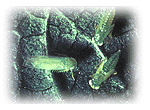
 |
Flow of Biota in the Atmosphere |
| Stuart H. Gage |
Organisms occupy many habitats within the earth system. One of the least studied locations where organisms occupy is the atmosphere. This is due to the difficulty of measurement and characterization of the atmospheric motion systems which organisms utilize to move over long distances to find, through active or passive use of these motion systems, new regions of the earth to inhabit. This precarious means of transport is used by a large array of biota ranging from microorganisms to large avian vertebrates. A group of scientists recently formed the Alliance of Aerobiology Research. A second, smaller organization, associated with AFAR and supported by the USDA, considers issues associated with movement of organisms in the atmosphere.
The goal of this coalition is to develop a set of hypotheses and to form cooperative strategies to address the complex issues associated with the movement of organisms in the atmosphere. The objective of the first phase of a coordinated program is to develop a proposal to support the activities of a group of investigators to characterize the flow of biota within the middle of the North American continent. The objective of the proposal is to establish a set of standard monitoring sites associated with permanent biological monitoring locations, meteorological observation stations and NEXRAD radar stations to measure the flow of organisms through and over this network of sites.
The Alliance for Aerobiology Research holds formal workshops and conferences to present findings of its members and to develop strategies for furthering knowledge about the flow of organisms in the atmosphere. A developing research agenda proposes to organize a network of monitoring sites within the central US corridor of known biotic flow and to organize the distribution of the site locations according ecosystem domains described by Bailey (1995).
Many studies by individials on the flow of selected organisms in the atmosphere have cotributed to understanding of the importance of the phenomenon to issues associated with agriculture (crop loss caused by aerial transported pathogens eg. corn blight), gene exchange between ecoregions, and movement to new ecoregions for reproduction. The availability of new technologies (NEXRAD), automated biological sampling devices, satellite imagery, digital national landscape databases, and atmospheric modeling tools provide new opportuinities to measure flow of organisms in the atmosphere. Techniques of measuring ecoregion greeing using AVHRR and methods of back trajectory modeling provide new potentials of interpretation of an age-old phenonema which is critical to understanding ecosystems processes and population dynamics of organisms.
This image sequence shows the greening process in the Mississippi River Valley and upper reaches of the midwest. This illustrates the dynamics of greening related to habitat susceptibility to organisms which may be transported over long distances by atmospheric motion systems.
 |
Models of upper air wind speed and direction provide evidence for potential transport and time of arrival of organisms which can move over long distances. The two sequences of a back trajectory model output, one from early May (left) and one from late May (right), show the variability of potential arrival of organisms at a loation in northwestern Ohio.
 |
 |
Collaborators
Scott Isard, UIC: Mike Irwin,UIC; Stuart Gage, MSU; John Westbrook, ARS, Charlie Main, NCSU; Margaret Maizel , NCRI;
Isard, S.A., M.E. Irwin and S.H. Gage. 1991. The alliance for aerobiology research: A mechanism to establish principles that govern the long distance aerial transport of biota. American Meteor. Soc.: Biometeor. and Aerobiology. 10th Conf. Proc., Pp. 85-89.
Carlson, J.D., M.E.Whalon, D.A. Landis and S.H. Gage. 1991. Springtime weather patterns coincident with long-range transport of potato leafhopper into Michigan. Agric. and Forest Meteorology. 59:183-206.
Alliance
for Aerobiology Research.
Top | KBS Regionalzation | KBS LTER home page | The LTER network
For information contact: gages@pilot.msu.edu
Document author(s): Stuart Gage
E-Mail: gages@pilot.msu.edu
Revised: December 09, 1996
URL: http://www.ent.msu.edu/esal/lter_region